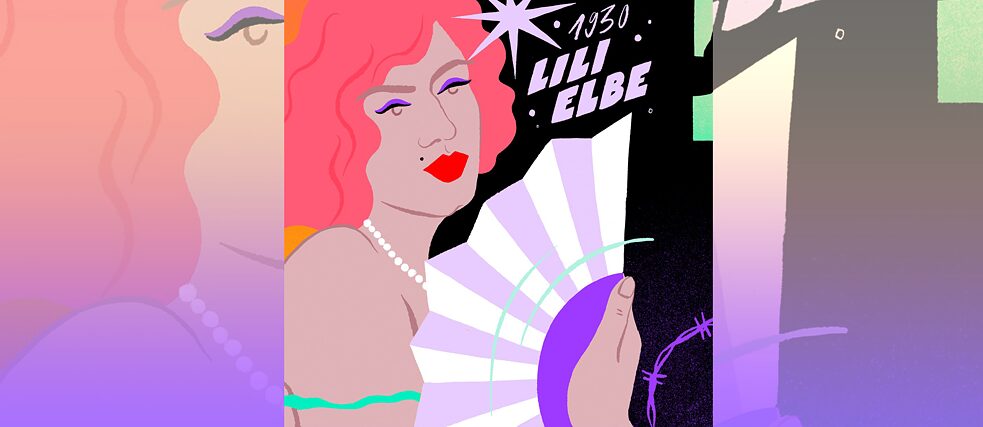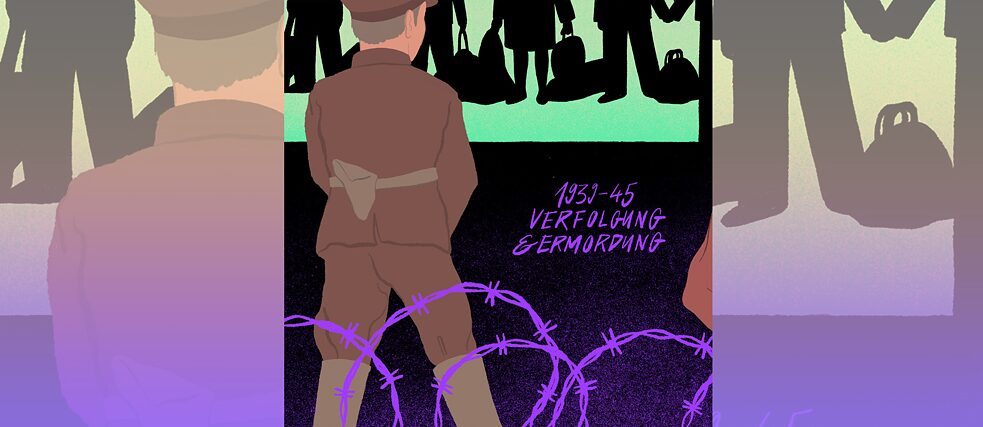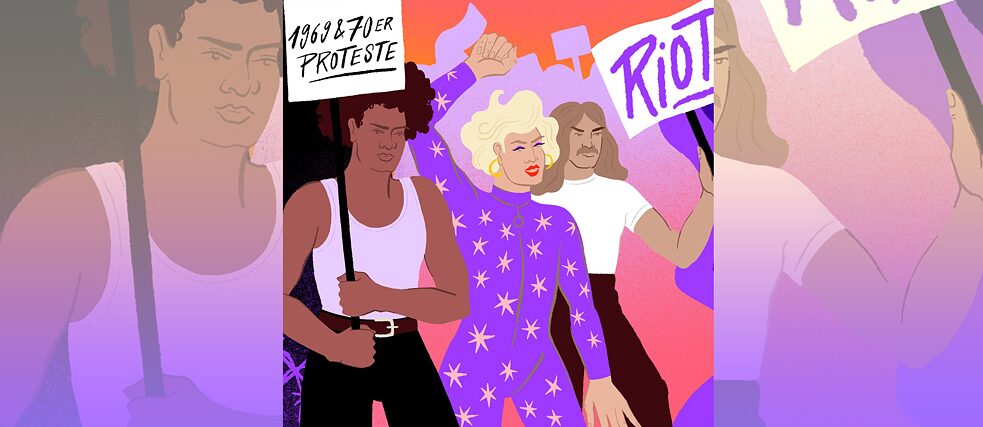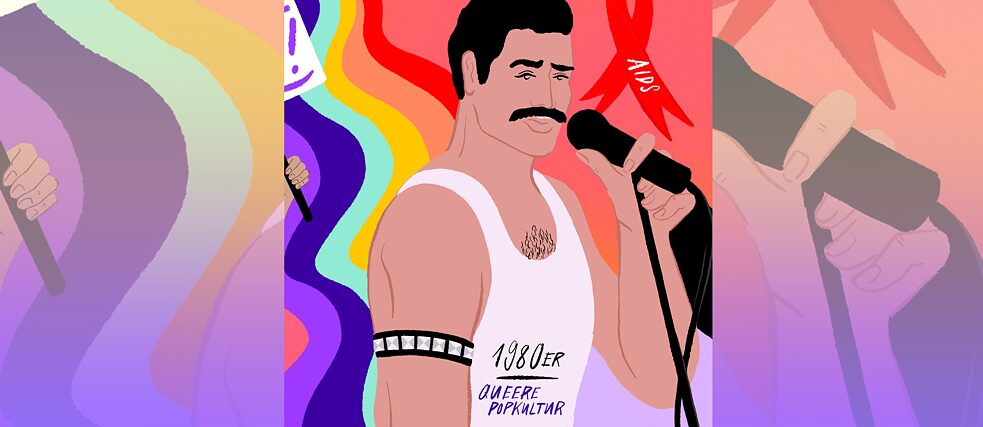Queer history
The Last Hundred Queer Years in Germany

"Anders als die Andern" was released in 1919 and deals with queer life. | Illustration © Rosa Kammermeier
It might seem flattering at first to present queerness as new, presented in a new futuristic design. Denying the history of transgender, intersex, homosexual and non-binary people is one of the most effective ways of undermining the queer community and calling its rights into question. We exist. And always have. So if any proof be needed, here’s a recap of the last hundred queer years in Germany.
By Regine Hader
The eternal Eldorado
Everyone coming to Berlin to party nowadays has at least heard of the Berghain club (a favourite gay hangout, by the way). Back in the 1920s, the Eldorado was the “place to be” in Berlin: a glitzy wonderland of sexual liberty in which revellers danced their defiance of the binary gender order. Word spread fast and soon got abroad: tourists were especially curious about the cabaret artists in drag. Then again, many members of the scene rebuked the Eldorado and other queer bars for serving up the artists to the curious crowd of straight thrill-seekers.
At the legendary Toppkeller at Schwerinstrasse 13, a lesbian haunt near Nollendorfplatz, the Berlin singer Claire Waldoff would sport a men’s suit whilst performing her political songs on stage to a crowd including the likes of dancer Anita Berber and even Marlene Dietrich, with whom she had an affair. Every night there, a dominatrix would intone the Lila Lied (the “Mauve Song”, Berlins queer anthem), with everyone joining in on the chorus: “Wir sind nun einmal anders als die Anderen” (“We’re just different from the others”).
The allusion is to Richard Oswald's film Anders als die anderen (“Different from the Others”), which came out in 1919 after the loosening of censorship laws. The first film to portray the beauty of homosexuality, it tells the tragic story of a man blackmailed for his sexual orientation. After being locked up by the police and vilified by society, he ends up killing himself.
After his suicide, a certain Dr Magnus Hirschfeld makes a rousing and revolutionary case for the rights of sexual minorities. Scriptwriters have yet to tell his story. An historical figure, Hirschfeld played himself in the film: a gay German physician and sexologist who explored sexual diversity and gave a vital boost to Germany’s queer movement. One of the most modern-minded scientists of his day, he called for the abolition of Paragraph 175 of the German Penal Code, which criminalized sexual relations between men.
Anders als die anderen was only screened a few times. The press pilloried this “perverted” picture, and the government banned it and had all the copies destroyed. It’s only thanks to a stroke of luck that we can still see some fragments of this historic film.
Queer pioneers and nascent Fascism
A decade after Hirschfeld's famous speech in the film, his Institut für Sexualwissenschaft (Institute of Sexual Research) undertook one of the first sex reassignment surgery on Lili Elbe, a lesbian painter from Denmark. Her story is eternized in David Ebershoff’s 2000 bestseller The Danish Girl, which was adapted for the screen in 2015. Hirschfeld is nevertheless controversial today, because scientists have not yet been able to conclusively clarify what role his research really played in eugenics.And Leontine Sagan made history a year later with Mädchen in Uniform (Girls in Uniform): a film directed and written by women with an all-female cast. and its productionmade it clear that women could not only be lesbians, but could also be sexually satisfied and artistically successful together, without men. Although the lovers tilt their heads back to kiss, the homophobic and misogynistic press denied its lesbian storyline and its celebration of female sexuality.
Whilst Hirschfeld and other activists were collecting signatures for a petition to abolish discriminatory laws, horrors were already brewing in Berlin. Sturmabteilung (SA) commander Ernst Röhm, who’d actually worked at the Eldorado for a while, remained a regular at the club… until in 1933 the Nazis began shutting down gay venues and persecuting, torturing, forcibly sterilizing, murdering and schlepping homosexuals off to the camps. Queer people, however, are not only victims of the Nazis, but fight against fascism like Frieda Belinfante, Maria Berner, Gertrude Sandmann, Klaus and Erika Mann, Willem Arondeus, Thérèse Pierre or Josefine Baker.
They had to wear an inverted pink triangle on their camp uniforms as a badge of shame. Being gay, kissing another man or even gay “intentions” were enough to be convicted of a felony or sent off to a concentration camp. Many queer women were tagged with an inverted black triangle as “asocials” or accused of being prostitutes. They were at the very bottom of the pecking order in the camps.
The Allies eventually defeated the Nazis and liberated the concentration camps in 1945. Although midnight on 8 May 1945 was designated a “Stunde Null” or “Zero Hour” in German history, some things didn’t change: after liberation, some queer survivors of the camps were actually locked up again on account of their sexuality. Mainstream society still felt they belonged in prison or concentration camps. Those convicted under Paragraph 175 were not considered victims of National Socialism, but criminals. So doctors continued sterilizing queer people actually attempted to “cure” them of their sexuality surgically by operating on their brains. Even in this hostile climate, however, some brave souls still fought for their rights.
From post-war to East German gay film
The Nazi version of Paragraph 175 actually remained in force in West Germany until 1969. It turns out – though this fact is swept under the rug to this day – that more homosexual men were convicted under Chancellor Konrad Adenauer (1949–1963) than in the whole Nazi era. So maybe it’s high time we came to grips with this dark chapter in West German history and renamed some of Germany’s city squares and foundations.
In 1950, East Germany, on the other hand, reinstated the Weimar Republic version of Paragraph 175 outlawing sexual relations between men. But East Berlin’s Appeal Court decided to stop applying the law, which was finally abolished there a decade later.
All the same, this was but a semblance of sexual liberty: queers were still excluded and persecuted, and later spied on, in East Germany. The state nixed their plans to put in an appearance with a separate banner at the World Festival of Youth and Students. So they withdrew to protected places like Leipzig University’s seminary school to debate the issues, to pool their forces and build networks. Like the peace movement, the East German queer scene organized to fight for change from the relative safety of this Protestant “refuge” (for want of any alternative havens).
For the epigraph to their 1983 internal paper, the gay association used a quote from the Austrian poet Ingeborg Bachmann: “Dass unsere Kraft weiter reicht als unser Unglück”, roughly “May our strength prevail over our misfortune.” As many as three thousand people turned out for the group’s events every year.
Coming to grips with the Nazi past was a matter that people in East as in West Germany would rather address without taking into account the thousands upon thousands of queer victims. A strange occurrence in 1984 at the Ravensbrück concentration camp memorial, of all places, proved a case in point: a group of lesbians laid a memorial wreath for their murdered “sisters”. When they returned to the site a few days later, the wreath was gone. And when they opened the guest book, they saw that their entry was missing without a trace, torn out as if it had never been there.
After a seven-year struggle, Heiner Carow, East German master of the art of telling love stories on the silver screen, was finally allowed to shoot some gay venues in Berlin. Famous transwoman and museum director Charlotte von Mahlsdorf also stars in the film, and her role as a barmaid shows just how diverse society is. Coming out was screened twice in a row in the night of its premiere. The audience was enthralled and utterly oblivious to the sea change that had rocked the world in the meantime: it was 9 November 1989, and after the curtain came down in the cinema they emerged to find the Berlin Wall had come down too.
Meanwhile in the West: Rosa von Praunheim, pop culture and Aids
West Germany couldn’t quite bring itself to legalize homosexuality, but it did decisively liberalize Paragraph 175. And a groundbreaking film came out two years later, in 1971: Nicht der Homosexuelle ist pervers, sondern die Situation, in der er lebt (“It Is Not the Homosexual Who Is Perverse, But the Society in Which He Lives”). Rosa von Praunheim recounts in this film the lives and loves of several gay men. At first, they seek to emulate the staid, narrow-minded married life of bourgeois couples: this was Praunheim’s critique of the conformism of the so-called Homophile Movement. “Bourgeois marriage hinges on child-breeding and the oppression of women,” he commented, and provocatively had his characters use the word “schwul”, a slang epithet for “gay” that was still taboo at the time.What Praunheim was calling for then came to pass in Münster in 1972, after queers had long since begun taking to the streets abroad: Germany’s first LGBT parade. And in 1979 Berlin hosted its first Christopher Street Day Parade commemorating the tenth anniversary of the Stonewall Uprising, a series of spontaneous riots, led by black trans women like Marsha P. Johnson, in protest against police violence and oppression during a raid at the Stonewall Inn in New York’s Greenwich Village.
Down in Munich, Cosy Piero was throwing legendary parties, attended by cis-heteros and homos as well as the whole gamut of genders and sexualities. Munich became a new queer hotspot in the ’80s. But when AIDS broke out, one friend after another died in many gay circles. High-profile politicians like Horst Seehofer, now interior minister, at the time suggested sticking HIV-positives all together in special homes: the gay community weren’t the only ones to shudder in horror at this proposal. It was a very trying time for many queers. Bavaria enacted a raft of harsh measures, including compulsory HIV testing for prostitutes and junkies. And all civil servants had to test HIV-negative to keep their jobs. And yet the 1980s were a heyday of queer pop culture and subculture. Even world stars like Freddy Mercury moved into Glockenbachviertel, a neighbourhood that had become the nucleus of Munich's gay community at the time.
And today? Confetti showers and contradictions
After more than a hundred years on the law books, Paragraph 175 was finally repealed in 1994. Many queer and camp styles reached their apogee in the 1990s. Under the influence of gender studies over in the US, the decade also saw the spread of academic research into queer issues and theories.The community finally succeeded in pushing through passage of civil partnership in Germany after the turn of the millennium. That milestone was followed 16 years later by the legalization of same-sex marriage in 2017 – which was duly fêted with a shower of confetti inside the Bundestag! After a long, hard struggle, the queer community had overcome yet another formidable hurdle on the rocky road to equal rights for all.
But various social phenomena still reflected society's ambivalence towards queers: While pop culture – from fashion and apps to music – had become one quotation of queer aesthetics after another, actors still had to fear for their careers if they came out of the closet. Although “tolerance” was loudly and proudly trumpeted throughout the land, the Bundestag that year nonetheless voted against a real right to self-determination for transgenders. Queer dating shows, parties and Netflix series abounded, but even in 2020 intersex people were still dismayed to find that Ehe für alle (“marriage for everyone”) doesn’t really include everyone. Queer logos may be conspicuous on every other shop window in town, but they’re not big enough to fill yawning gaps in research into the queer history of the nation.
In sum, the queer community certainly haven’t had an easy time of it over the past hundred years. And queer history doesn’t always suggest things are going to be good for us, let alone better that before. But one thing we do know now is: we exist. It's impressiv how queers stand up for themselves against all odds. It's equally impressiv that a society that inherits centuries of oppression and represses queer history thinks that love equals love. Wouldn’t it be a fine thing if society came to understand now that queers don't owe the normative mainstream a thing: no threesome sex, no explanations, no clear-cut binary choices, no comings-out, no silent acceptance of lower pay or of heavier pressure to be a little better and more innovative than the others, no debate about whether we’re asking too much too fast, now that a lot has indeed improved. We may well be the future. But we’re also the past – albeit a past that some folks would still keep sub rosa – for we are clearly nothing new.




